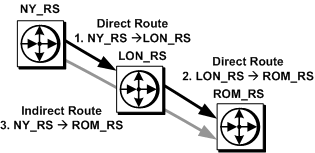Create routes at the source Replication Server.
When you create either direct or indirect routes, the destination Replication Server creates and materializes subscriptions at the destination site for the replicated RSSD system tables. This process lets the destination Replication Server receive available replication definitions and function classes.
When you create an indirect route, Replication Server does not create an RSI queue. The indirect route uses the RSI outbound queues of the direct route segments that compose the indirect route.
For Replication Server to be able to begin transferring system information to the destination Replication Server, you must create direct routes before you create an indirect route.
For example, you cannot create an indirect route (1 to 3) unless you have already created two direct routes (1 to 2 and 2 to 3). You also must set up the routes in the correct order.
